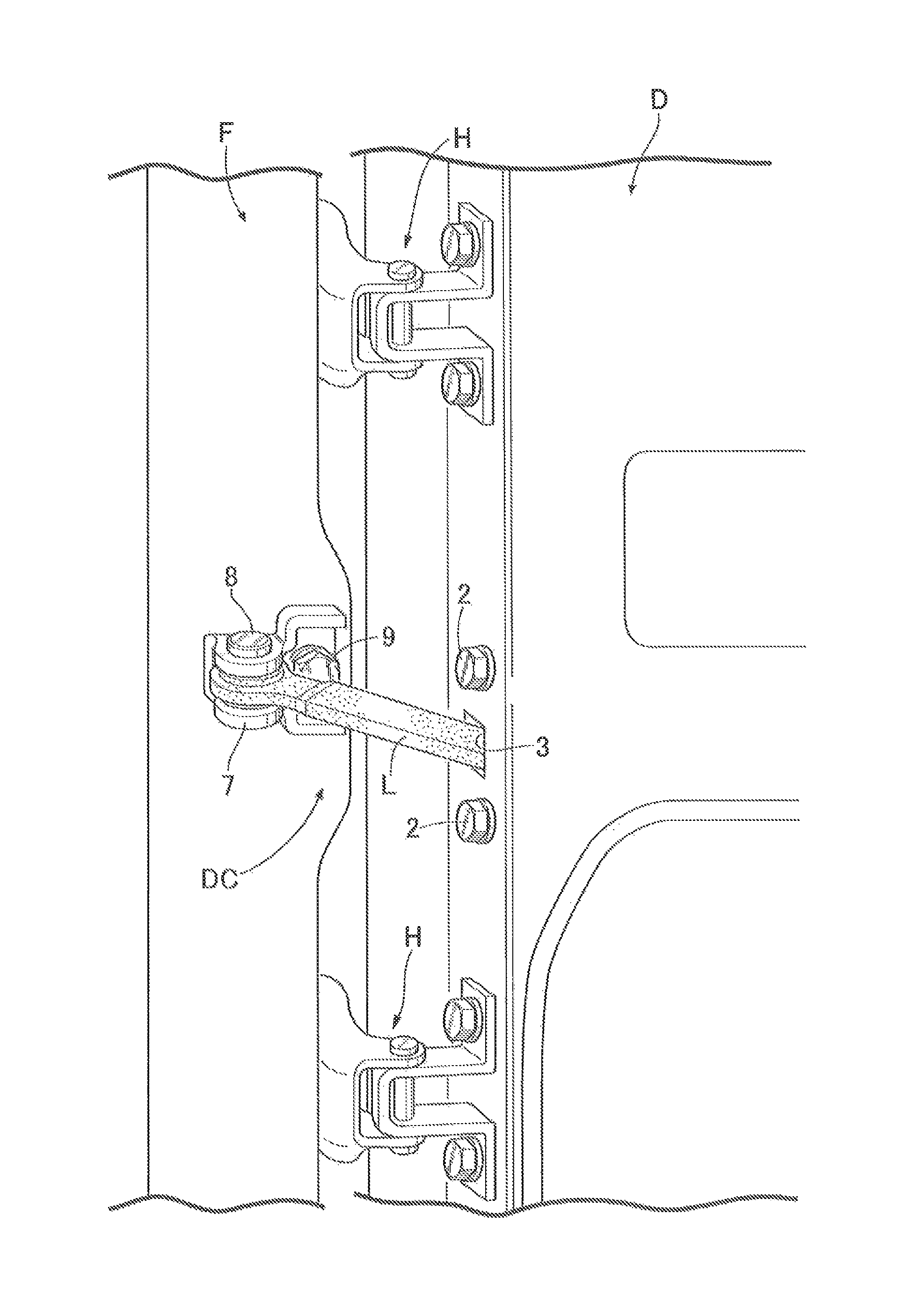Vehicle door checker
a vehicle door and checker technology, applied in the field of vehicle door checkers, can solve the problems of deterioration, cracking of the reinforcing portion, separation, damage, etc., and achieve the effect of simple structur
- Summary
- Abstract
- Description
- Claims
- Application Information
AI Technical Summary
Benefits of technology
Problems solved by technology
Method used
Image
Examples
first embodiment
[0030]Descriptions will be hereinbelow provided for embodiments of the present invention on the basis of the accompanying drawings. To begin with, a first embodiment will be described with reference to FIGS. 1 to 7.
[0031]First of all, descriptions will be provided for an overall structure of a door checker. In FIG. 1, a door D for opening and closing an entrance is rotatably attached to a vehicle body F of an automobile via hinges H, and the door checker DC is attached between the vehicle body F and the door D.
[0032]As shown in FIGS. 2 to 6, the door checker DC includes a case C fixedly attached to an inner surface of an end wall of the door D. The case C is formed from: a case body 1 as a support body, having a box shape with one end opened, and obtained by press-forming a metal plate such as a steel plate or the like; and a cover 1′ made of a metal plate such as a steel plate or the like, and connected to the case body 1 while covering the opened end of the case body 1. While abut...
second embodiment
[0053]For this reason, in the second embodiment, in a case where when the door D reaches the predetermined full-open position, as shown in FIG. 8A, the full-open stopper ST of the check lever L is engaged with the stopper surfaces f1, f2 of the case body 1 in the proper contact posture, first of all, the pair of metal-made protrusions Ms (the first stopper portions) are engaged with the pair of the first stopper surfaces f1. When the case body 1 is deformed due to impact caused by the engagement, and the first stopper surfaces f1 are slightly set back, the pair of synthetic resin-made swelling portions Ps (the second stopper portions) are engaged with the second stopper surfaces f2. Thereby, the load produced by opening the door can be securely received mainly by engagement of the metal-made protrusions Ms (the first stopper portions) with the pair of first stopper surfaces f1, and load burden on the pair of synthetic resin-made swelling portions Ps (the second stopper portions) can...
third embodiment
[0056]For this reason, in the third embodiment, in a case where when the door D reaches the predetermined full-open position, as shown in FIG. 9A, the full-open stopper ST of the check lever L is engaged with the stopper surfaces f1, f2 of the case body 1 in the proper contact posture, first of all, the pair of synthetic resin-made swelling portions Ps (the second stopper portions) are engaged with the second stopper surfaces f2. After the engagement, as shown in FIG. 9B, the pair of metal-made protrusions Ms (the first stopper portions) are engaged with the pair of the first stopper surfaces f1.
[0057]Thereby, at the opening limit of the door D, when the full-open stopper ST is engaged with the stopper surfaces f1, f2, first of all, impact caused by the engagement is effectively absorbed and eased by elastic deformation of the pair of synthetic resin-made swelling portions Ps (the second stopper portions). Thereafter, the pair of metal-made protrusions Ms (the first stopper portions...
PUM
 Login to View More
Login to View More Abstract
Description
Claims
Application Information
 Login to View More
Login to View More - R&D
- Intellectual Property
- Life Sciences
- Materials
- Tech Scout
- Unparalleled Data Quality
- Higher Quality Content
- 60% Fewer Hallucinations
Browse by: Latest US Patents, China's latest patents, Technical Efficacy Thesaurus, Application Domain, Technology Topic, Popular Technical Reports.
© 2025 PatSnap. All rights reserved.Legal|Privacy policy|Modern Slavery Act Transparency Statement|Sitemap|About US| Contact US: help@patsnap.com



